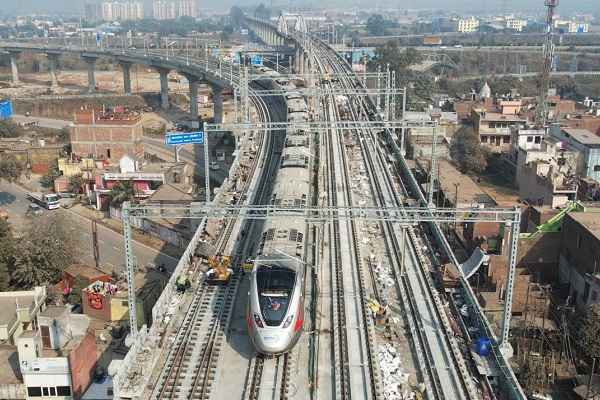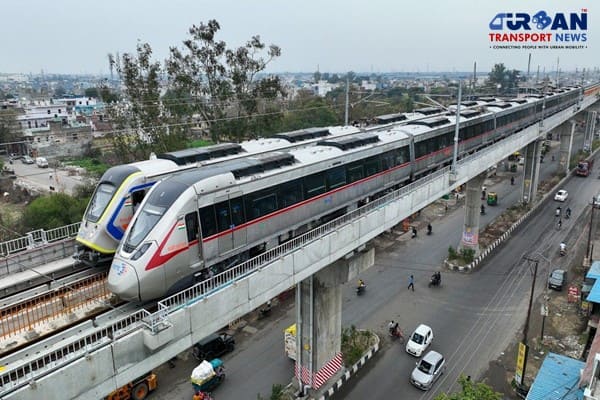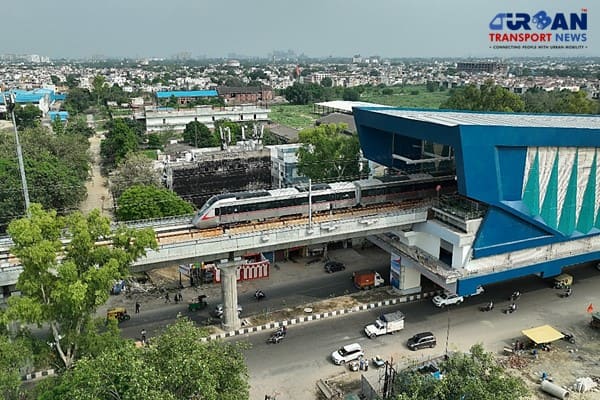 Qatar approves Saudi Rail Link Agreement, Accelerating Gulf Railway Vision 2030
Qatar approves Saudi Rail Link Agreement, Accelerating Gulf Railway Vision 2030 UP Govt plans to introduce Water Metro services in Ayodhya, Varanasi & Prayagraj
UP Govt plans to introduce Water Metro services in Ayodhya, Varanasi & Prayagraj India’s First Urban Ropeway begins Trial Run in Varanasi, Set to carry 1 Lakh passengers daily
India’s First Urban Ropeway begins Trial Run in Varanasi, Set to carry 1 Lakh passengers daily India and Bhutan to Build First-Ever Rail Link: ₹4,033 Cr Project to Boost Regional Connectivity
India and Bhutan to Build First-Ever Rail Link: ₹4,033 Cr Project to Boost Regional Connectivity Patna to launch Eco-Friendly Water Metro; Trial Run soon between Digha and Kangan Ghats
Patna to launch Eco-Friendly Water Metro; Trial Run soon between Digha and Kangan Ghats Air India Group set to launch Flights Operations from Navi Mumbai International Airport
Air India Group set to launch Flights Operations from Navi Mumbai International Airport Chennai to launch 25-Year Mobility Plan with Unified QR Ticketing and One-App Transit System
Chennai to launch 25-Year Mobility Plan with Unified QR Ticketing and One-App Transit System Kochi Metro bags ₹4.4 crore contract to prepare DPR for Mumbai Water Metro Proejct
Kochi Metro bags ₹4.4 crore contract to prepare DPR for Mumbai Water Metro Proejct Navi Mumbai International Airport set for September launch; IndiGo and Akasa Air to lead Operations
Navi Mumbai International Airport set for September launch; IndiGo and Akasa Air to lead Operations Noida International Airport to be Inaugurated on October 30, Commercial Flights in 45 Days
Noida International Airport to be Inaugurated on October 30, Commercial Flights in 45 Days
Innovating Regional Mobility: A glimpse into the India's first Regional Rapid Transit System

India's first Regional Rapid Transit System (RRTS) represents a groundbreaking advancement in the nation's transportation landscape. Designed to revolutionize regional mobility, the RRTS is a high-speed, high-frequency rail-based system specifically crafted for intercity and regional commutes. By leveraging cutting-edge technologies, efficient train control systems, and state-of-the-art infrastructure, the RRTS promises to significantly reduce travel time, congestion, and carbon emissions. This innovative project is set to provide a seamless and comfortable commuting experience for millions, contributing to the economic development and overall quality of life in the region. By integrating elements of speed, safety, and sustainability, the RRTS sets a new standard for modern transportation solutions, ushering in a new era of rapid and reliable connectivity for urban and suburban areas alike.
System Overview
India's first Regional Rapid Transit System (RRTS) is a transformative project spearheaded by the National Capital Region Transport Corporation (NCRTC). The RRTS is a high-speed rail network designed to enhance regional connectivity and redefine urban transportation. With a focus on speed, safety, and sustainability, the RRTS aims to revolutionize the way people travel within the National Capital Region (NCR) of India.
Phase 1 Corridors:
-
Delhi – Ghaziabad – Meerut RAPIDX Corridor (85.15 km): This corridor is set to revolutionize travel between Delhi, Ghaziabad, and Meerut. With its cutting-edge infrastructure and rapid transit capabilities, it promises to reduce travel time and enhance connectivity for commuters across these cities.
-
Delhi – Gurugram – SNB – Alwar RAPIDX Corridor (106.0 km): Linking Delhi, Gurugram, SNB, and Alwar, this corridor ushers in a new era of regional connectivity. Its focus on speed and efficiency paves the way for enhanced travel experiences and economic growth.
-
Delhi – Panipat RAPIDX Corridor (103.0 km): The Delhi-Panipat corridor is poised to redefine intercity travel, providing a swift and convenient connection between the two cities. This corridor holds the potential to reshape the dynamics of commuting and regional development.
Other Transformative Corridors:
-
Delhi – Faridabad – Ballabgarh - Palwal RAPIDX Corridor: This corridor envisions improved connectivity between Delhi, Faridabad, Ballabgarh, and Palwal. With its integration of advanced technologies, it promises a seamless journey for residents and commuters.
-
Ghaziabad – Khurja RAPIDX Corridor: The Ghaziabad-Khurja corridor demonstrates NCRTC's commitment to expanding high-speed connectivity. By bridging the gap between these two regions, it amplifies accessibility and convenience.
-
Delhi - Bahadurgarh - Rohtak RAPIDX Corridor: Connecting Delhi, Bahadurgarh, and Rohtak, this corridor is set to enhance regional accessibility and foster economic growth. Its efficient rail-based system aims to redefine travel patterns.
-
Ghaziabad-Hapur RAPIDX Corridor: The Ghaziabad-Hapur corridor is poised to bolster regional connectivity, offering a rapid and reliable link for commuters. Its seamless integration into the RRTS network transforms travel experiences.
-
Delhi-Shahadra-Baraut RAPIDX Corridor: The Delhi-Shahadra-Baraut corridor underscores the comprehensive nature of the RRTS project. By connecting these regions, it contributes to a holistic and integrated urban transportation system.
Visionary Leadership: Vinay Kumar Singh
Vinay Kumar Singh, a seasoned civil engineer and Urban Infra Leader, commenced his professional journey within the Indian Railways (IRSE 1988 batch). With academic excellence from MNIT, Ahmedabad, and a MTech in Civil Engineering from IIT, Delhi, Singh stands as a visionary leader at the forefront of regional mobility transformation. As the first Managing Director of NCRTC, he spearheads the design, development, finance, and maintenance of the Regional Rapid Transit System (RRTS) in the National Capital Region of India. Armed with an intricate understanding of rail-based systems and advanced technologies, Singh navigates the implementation of the RRTS – an endeavor that represents one of India's most technologically advanced transport projects. Singh envisions taking commuting in the NCR to unprecedented levels, surpassing the transformation brought by metro systems over the last two decades. His extensive exposure to international railway systems, metro systems, and loan negotiations for various projects positions him as a trailblazer in the industry.
Overcoming Challenges: Transforming the Commute
Early Focus on Commuter Needs
NCRTC's trajectory towards operationalizing the priority section of Delhi-Meerut RRTS showcases unwavering commitment. Embracing a "commuter-first" ethos over the convenience of construction, the organization's approach prioritizes commuter comfort and requirements. The decision to strategically position an RRTS station near existing infrastructures, such as Indian Railway Stations and Metro Stations, underscores this principle. This decision, though presenting challenges, ultimately serves the commuters better by facilitating seamless transitions between various modes of transport.
Multi-State Implementation: A Complex Landscape
The ambitious RRTS project spans multiple states, necessitating intricate engagement with diverse stakeholders. The project's complexity requires meticulous approvals and No Objection Certificates (NOCs) even before construction commences. The urban environment's density amplifies the challenges, including limited availability of land. However, NCRTC proactively mitigates this by adapting its alignment to minimize the land footprint and strategically utilizing government-owned land, thereby navigating the hurdles associated with urban expansion.
Steady Progress and Achievements
Singh's astute leadership has propelled the project, resulting in a significant milestone. Within a mere four years since commencing construction, NCRTC received approval from the Ministry of Railways and the Commissioner for Metro Rail Safety (CMRS) in June 2023. This achievement heralds the inauguration of the 17-kilometer-long priority section of the Delhi-Ghaziabad-Meerut RRTS corridor – a pioneering feat as India's first fully operational railway system along its entire length, boasting a maximum operational speed of 160 kmph.
RAPIDX: Revolutionizing Regional Mobility
RRTS vs. Existing Services
Distinguishing itself from existing metro, bus, and railway services, the RRTS service is purpose-built. It caters to regional and intercity commutes, encompassing longer travel distances, typically ranging from 50 km to 100 km. Notably, RRTS stations are spaced farther apart – around 5-7 km – a departure from the 1-1.5 km spacing typical in metro systems. This unique design is tailored to the demands of regional travel.
The Essence of RAPIDX
The brand "RAPIDX" encapsulates the essence of this groundbreaking service. The name effortlessly resonates with various languages, signifying speed and progress. The inclusion of 'X' represents next-generation technology and signifies innovation and optimism. As a harbinger of youth and energy, RAPIDX ushers in a new era of rail-based travel solutions.
Pioneering Technologies: RRTS Innovations
Advanced Train Control System
RRTS's status as India's first Regional Rail has spurred a wave of innovation. The project embraces cutting-edge technologies, many of which are being introduced to the country for the first time. To adhere to the "Make in India" initiative, RRTS's modern trainsets, designed to reach speeds of 180 kmph, are manufactured in Savli, Gujarat.
Interoperability and Safety
Seamless commuter movement across the priority RRTS corridors is a pivotal objective. This is realized through interoperability facilitated by hybrid Level 3 technology from the European Train Control System (ETCS). By integrating advanced signalling, train control systems, and automatic train operation over Long-Term Evolution (LTE) radio, NCRTC sets a global precedent.
Strategic Partnerships and Indigenous Innovations
NCRTC's strategic approach has also led to indigenous developments. Platform Screen Doors (PSDs), developed in-house, eliminate the need for imports from abroad, aligning with the "Atmanirbhar Bharat" initiative. Furthermore, precast ballastless slab track technology, a first in India, ensures robustness and efficiency for speeds of 180 kmph.
Timely Implementation: The Guiding Principles
Early Risk Mitigation
Ensuring timely RRTS implementation is a result of meticulous risk assessment and mitigation strategies. Early-stage utility shifting and road widening through independent contracts alleviated potential obstacles, ensuring unobstructed construction progress.
Digital Tools and Efficiency
Digital tools played a pivotal role in expediting RRTS implementation. Techniques like pre-casting facilitated construction within a heavily operational highway median. These digital tools also offer real-time project management dashboards, enabling swift and informed decisions.
Private Sector Efficiency: Operation and Maintenance
Innovations in O&M
NCRTC's innovation extends to operations and maintenance (O&M). An international bidding process resulted in Deutsche Bahn (DB) RRTS India securing a 12-year comprehensive O&M contract. This leapfrog initiative not only optimizes O&M costs but also enhances industry knowledge and domestic capabilities.
Bundled Maintenance and Efficiency
Another innovative stride involves bundling 15-year rolling stock maintenance with supply contracts awarded to Alstom. This holistic approach ensures optimal lifecycle management and knowledge transfer, setting new benchmarks in rail-based asset maintenance.
Ensuring Safety: Unique Protocols
Rigorous Safety Measures
Safety protocols for RRTS transcend regulatory norms. The system integrates advanced signalling, train protection systems, and automatic train control systems, effectively minimizing accident risks. Centralized control mechanisms with secure access ensure operational and maintenance safety.
Training for Rail Safety
Recruitment and training initiatives are instrumental in ensuring rail safety. Tailored training equips personnel with operation, maintenance, and emergency safety procedure expertise, enhancing overall rail system safety.
Fare Structures and Beyond
A Balanced Fare Approach
The fare structure for the Delhi-Meerut RRTS corridor is a balanced amalgamation of ridership maximization, revenue maximization, and competitive fare rates. This approach aligns with the larger goal of maximizing societal benefits while ensuring affordability. However, it is expected that the fare will be charged at the rate of Rs 2 per km. This means the entire Delhi-Meerut transit may cost Rs 160 and the Duhai-Sahibabad transit will cost Rs 34.
Conclusion
The RRTS's transformative impact extends beyond mere transportation – it promises to reshape urban landscapes, stimulate economic development, and elevate the quality of life for millions. The integration of advanced technologies, efficient rail systems, and sustainable practices positions the RRTS as a beacon of progress, setting new benchmarks in modern transit solutions.







